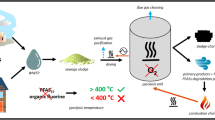The research discussed in this article was performed to make the processing of sludge formed in the electrolytic refining of copper more efficient. Results are presented from studies involving selection of the reagent regime and optimization of the conditions for leaching lead from tailings formed in the flotation concentration of decopperized sludge. The main components of the raw materials that were studied: lead oxysulfate (up to 60%) and oxidized complex compounds of antimony (up to 30%). Industrial complexons were proposed for use as the solvents. The tests showed that preference should be given to the use of alkaline solutions of oxyethylenediphosphoric (OEDP) acid. The kinetic features of the process were studied by using a method which employs a rotating disk of synthetic tribasic lead sulfate. The experimental rate constant for the leaching of lead in an OEDP solution reaches 6·10−6 g-ion/(cm2·sec). It was established that the process is diffusional in nature and that the effect of temperature is negligible. A large-scale balance experiment involving the removal of lead from flotation tailings was performed in a laboratory. The experiment established that the level of recovery of lead in an alkaline solution of OEDP reaches 85% and that the other important components of the sludge (antimony and noble metals) remain almost entirely in the undissolved residue.


Similar content being viewed by others
References
S. A. Mastyugin, N. A. Volkova, S. A. Naboichenko (ed.), and M. A. Lastochkina, Sludges from the Electrolytic Refining of Copper and Nickel, UrFU, Ekaterinburg (2013).
V. G. Lobanov, S. A. Mastyugin, R. S. Voinkov, et al., “Possible ways of improving the processing of sludge from the electrolytic refining of copper,” Tsvetn. Met., No. 10, 45–50 (2014).
M. Z. Ugorets, L. I. Mekler, T. I. Glazkova, et al., “Factory tests of the chemical beneficiation of sludge from the electrolytic refining of copper,” Tsvetn. Met., No. 1, 25–26 (1976).
M. Z. Ugorets, T. I. Glazkova, et al., “Hydrometallurgical extraction of lead and antimony from sludge formed in the electrolytic refining of copper,” in: The Systematic Use of Raw Materials in Nonferrous Metallurgy, UNTs AN SSSR, Sverdlovsk (1980), pp. 63–66.
V. I. Spitsyn and L. I. Marynenko, Inorganic Chemistry, MGU, Moscow (1994), Part II.
T. S. Shalaeva, A. V. Yuzhanin, S. A. Mastyugin, et al., Patent No. 2071978 RF, IPC6 C22B7/00, “Method of processing sludge from electrolytic copper refining,” subm. 05.13.1992, publ. 01.20.1997.
T. S. Shalaeva, A. V. Yuzhanin, E. G. Kremko, et al., Patent No. 2109823 RF, IPC6 C22B7/00, “Method of processing sludge from electrolytic copper refining,” subm. 02.10.1997, publ. 04.27.1998.
T. M. Khafizov, A. V Volynchuk, K. A. Plekhanov, et al., Patent No. 2131473 RF, IPC6 C22B7/00, “Method of conditioning a lead-bearing material before refining,” subm. 06.04.1998, publ. 06.10.1999.
A. M. Belen’kii, G. V. Petrov, and T. N. Greiver, “Leaching of lead antimonite from decopperized sludge formed in the electrolytic refining of copper,” Tsvetn. Met., No. 6, 24–26 (1986).
G. Knaut and W. Wesemann, Patent No. 279272 GDR, “Method of extracting lead from deselenized and decopperized anode sludge,” publ. 05.30.1990.
T. Yanagida, S. Saito, N. Nosoda, and F. Kaneko, Patent No. 3944414 US, “Treatment of anode slime from copper electrolysis,” 03.16.1976.
S. A. Vzorodov, L. D. Shevelava, et al., “Production of lead by processing sludge from the electrolytic refining of copper,” Tsvetn. Met., No. 7, 21 (1982).
S. V. Karelov, O. S. Anisimova, S. V. Mamyachenkov, and V. A. Sergeev, “Leaching of lead-bearing cakes from zinc production in a complex-forming solvent,” Izv. Vyssh. Uchebn. Zaved. Tsvetn. Met., No. 2, 20–24 (2008).
Author information
Authors and Affiliations
Corresponding author
Additional information
The following also participated in the study: S. S. Nabloichenko (UrFU) and T. Z. Gibadullin (Uralelektromed’).
Translated from Metallurg, No. 8, pp. 89–93, August, 2015. Original article submitted June 17, 2015.
Rights and permissions
About this article
Cite this article
Voinkov, R.S., Mastyugin, S.A., Korolev, A.A. et al. Features of the Leaching of Lead from Slurry-Production Middlings by Industrial Complexons. Metallurgist 59, 733–739 (2015). https://doi.org/10.1007/s11015-015-0167-5
Received:
Published:
Issue Date:
DOI: https://doi.org/10.1007/s11015-015-0167-5




